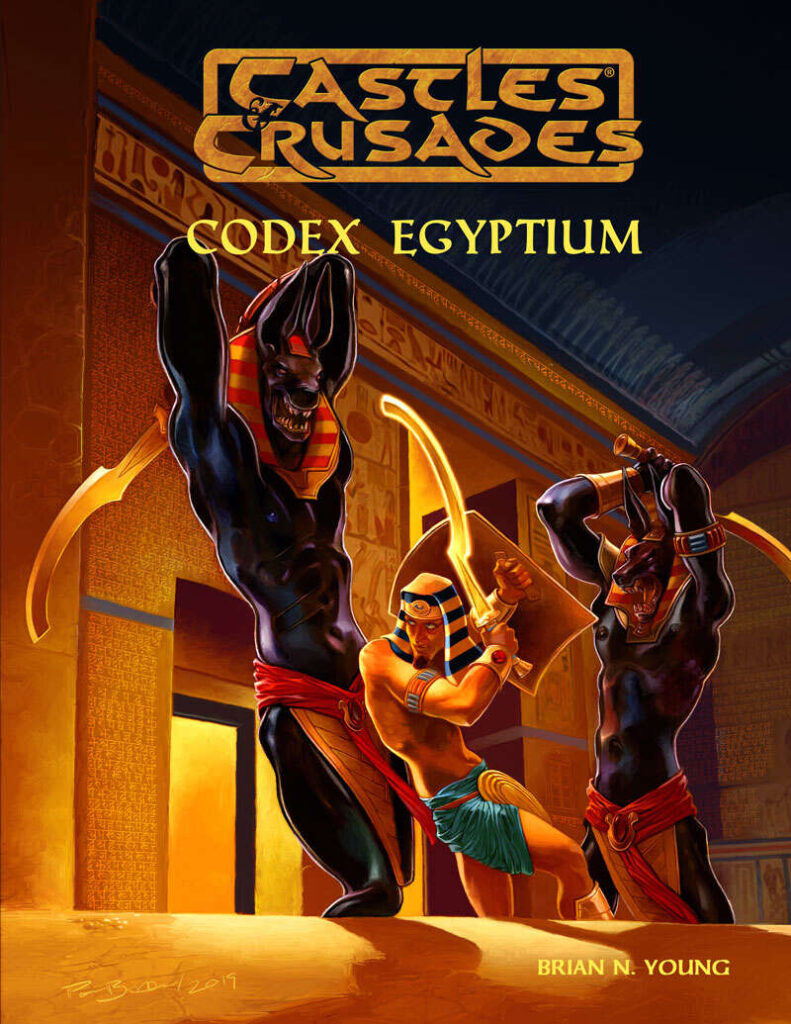Publisher: Troll Lord Games
Introduction
Castles & Crusades is a fantasy role-playing game that combines the classic feel of old-school games with the modern rules of the d20 system. The game is known for its simplicity, flexibility, and versatility, allowing players and game masters to create and run any kind of fantasy adventure they can imagine.
One of the features of Castles & Crusades is the Mythos Series, a line of supplements that explore the rich and diverse cultures and mythologies of the world. Each book in the series focuses on a specific region or theme, providing historical and cultural background, new character options, new magic and items, and new monsters and creatures.
In this review, I will take a look at one of the latest books in the Mythos Series: Castles & Crusades Codex Egyptium. This book is a supplement that explores the ancient and mysterious land of Egypt, its gods, its magic, and its monsters. The author, Brian Young, has done a remarkable job of researching and presenting the history, geography, religion, magic, and monsters of Egypt in a way that is both accurate and engaging.
Content
Castles & Crusades Codex Egyptium is a 128-page hardcover book with full-color illustrations. The book is divided into four chapters: The Land of Egypt, The Gods of Egypt, The Magic of Egypt, and The Monsters of Egypt.
The Land of Egypt
The first chapter provides an overview of the physical and political landscape of Egypt, as well as its culture and society. It covers topics such as the Nile river, the pyramids, the pharaohs, the social classes, the writing system, the art and architecture, and the daily life of the ancient Egyptians. The chapter also includes a timeline of major events in Egyptian history, from the prehistoric era to the Roman conquest.
The chapter is very informative and interesting, giving a lot of details and facts about Egypt that can be used to create realistic and immersive settings and scenarios for Castles & Crusades games. The chapter also provides some suggestions on how to adapt Egyptian elements to different fantasy genres, such as sword and sorcery, high fantasy, or horror.
The Gods of Egypt
The second chapter delves into the complex and fascinating pantheon of Egyptian gods and goddesses, their domains, their symbols, their relationships, and their worship. The chapter lists over 40 deities from Egyptian mythology, each with a description, an alignment, a domain, a symbol, a favored weapon, a portfolio (a list of aspects or spheres of influence), and a dogma (a statement of beliefs or principles).
The chapter also includes rules for creating Egyptian clerics and paladins, as well as new spells and items related to the divine powers. Some examples are:
- Ankh: A holy symbol that grants a bonus to healing spells.
- Eye of Horus: A protective amulet that wards off evil.
- Sistrum: A musical instrument that can charm or frighten enemies.
- Crook and Flail: A ceremonial weapon that can smite foes or command allies.
The chapter is very comprehensive and captivating, giving a lot of depth and flavor to the Egyptian gods and their followers. The chapter also provides some tips on how to incorporate Egyptian religion into Castles & Crusades games, such as creating temples, cults, festivals, rituals, oracles, or divine interventions.
The Magic of Egypt
The third chapter explores the arcane and occult aspects of Egyptian magic, such as the Book of the Dead, the mummification process, the ka and ba souls, the akh spirit, and the duat underworld. The chapter also introduces new rules for creating Egyptian wizards and sorcerers, as well as new spells and items related to the arcane arts. Some examples are:
- Canopic Jar: A container that preserves organs for resurrection.
- Cartouche: A seal that protects from curses or traps.
- Hieroglyph: A symbol that can create various magical effects.
- Pyramid: A structure that enhances magic or grants immortality.
The chapter is very intriguing and creative, giving a lot of options and possibilities for Egyptian magic and its users. The chapter also provides some advice on how to use Egyptian magic in Castles & Crusades games, such as creating scrolls, tomb robbers, necromancers, or secret societies.
The Monsters of Egypt
The fourth chapter presents a variety of monsters and creatures that inhabit or are inspired by Egypt, such as crocodiles, scorpions, sphinxes, mummies, amulets, scarabs, serpopards, and more. Each monster entry includes a description, statistics, special abilities, and combat tactics.
The chapter is very diverse and fun, giving a lot of challenges and surprises for Egyptian adventures. The chapter also provides some guidelines on how to create or modify monsters for Castles & Crusades games, such as adding templates, traits, or variants.
Conclusion
Castles & Crusades Codex Egyptium is a must-have for any fan of Castles & Crusades who wants to add some exotic flavor and adventure to their game. It is also a great resource for anyone who is interested in learning more about the ancient and mysterious civilization of Egypt. Whether you want to explore the pyramids, encounter the gods, wield powerful magic, or face fearsome monsters, this book has something for you. I highly recommend it!
Castles & Crusades Codex Egyptium on DrivethruRpg
